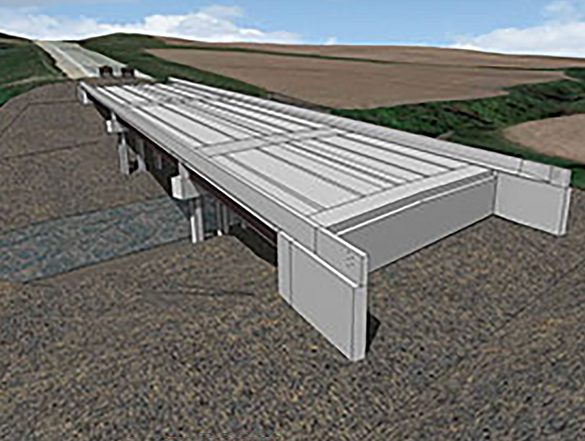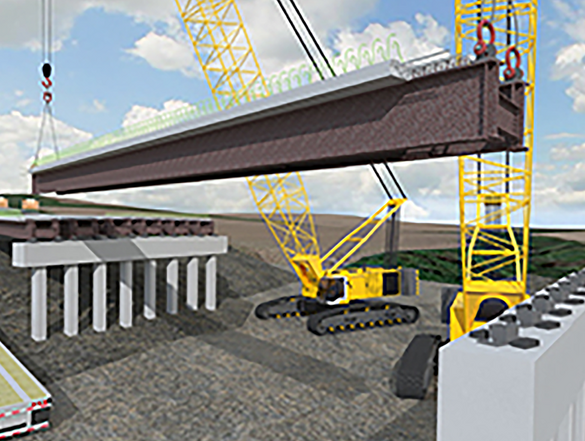On this page...
The Iowa 92 over Little Silver Creek bridge replacement project incorporated numerous innovative technologies contributing toward advancements in project safety, construction schedule, construction impact, project quality, user satisfaction, and service life.
This bridge replacement project represented Iowa DOT’s second-generation design efforts for accelerated bridge construction (ABC) using prefabricated bridge elements and systems (PBES). Generally based on the U.S. 6 over Keg Creek modular decked beam concept, the Iowa 92 over Little Silver Creek project built upon the experience gained and lessons learned from the department’s 2011 Strategic Highway Research Program SHRP2 Project R04, demonstration project.
The Iowa 92 over Little Silver Creek bridge replacement project has been recognized by the Federal Highway Administration for accelerated implementation and adoption of innovative technology in highway transportation. This project received an incentive funding grant of $1 million as a part of FHWA’s Accelerated Innovation Deployment (AID) program.
Back to topProject Overview

Constructed in the fall of 2015, the project replaced the bridge on Iowa 92 over Little Silver Creek, in Pottawattamie County. The previously existing 150’ x 28’ continuous concrete beam bridge was constructed in 1953 and was classified as structurally deficient. The bridge replacement increased the structural capacity of the bridge, improved roadway conditions, and enhanced safety by providing a wider roadway.
The replacement structure is a three-span, 234’ x 44’ modular rolled steel beam bridge. Concept selection for this structure was based on consideration of several factors, including: (1) minimized impact to highway users through implementation of an accelerated construction schedule; (2) demonstration of innovative design, construction, and material technologies; and (3) evolution and improvement of the modular decked beam method of accelerated bridge construction, first deployed in Iowa during the U.S. 6 over Keg Creek Strategic Highway Resource Program, SHRP2-Project R04, demonstration project.
The superstructure of the Iowa 92 over Little Silver Creek replacement bridge consists of 18 prefabricated, decked beam modules. Each module consists of a nominal 7’ strip of concrete deck cast on a pair of rolled steel beams. The modules were fabricated off-site and hauled to the project area for final assembly and connection under an accelerated construction schedule.

The bridge substructure incorporated simplified details that allowed for rapid construction. Steel bearing piling was employed to directly support structural concrete caps at the piers and abutments. The structural concrete caps serve as the seats for the prefabricated superstructure modules.
After construction of the substructure, the prefabricated superstructure modules were lifted into place and adjusted into position. The modules were connected to each other using narrow longitudinal joints filled with ultra-high performance concrete and the superstructure system was connected to the substructure using high performance concrete transverse closure pours.
The combination of accelerated construction techniques considerably reduced the duration that highway users were impacted. Under normal, non accelerated conditions, a typical bridge replacement project at this site would likely have required approximately six months of full road closure. However, the accelerated construction technologies incorporated into this project allowed the highway impact duration to be limited to a total of 61 days, of which only 21 days required full road closure (two-way traffic was maintained with construction zone traffic control for the remainder of the 61 day construction schedule). The total impact duration (61 days) and the road closure duration (21 days) represent schedule savings on the order of 66 percent and 88 percent, respectively, compared to conventional, non accelerated construction.
Whereas the U.S. 6 over Keg Creek project was intended to serve as proof-of-concept for this method of accelerated bridge construction, the Iowa 92 over Little Silver Creek project was intended to evaluate a broadened application of this technology. For this project, a deliberately more challenging site was selected. A primary objective of this project was to provide the department with valuable data on the suitability and cost-effectiveness of these construction techniques, as applicable to a range of geometric scenarios representative of many typical bridges across the state. Iowa’s proof-of-concept deployment was on a square (non skewed), relatively level road alignment, with generally agreeable site access. In contrast, the Little Silver Creek project included 20° skew, considerable vertical curvature of the road alignment, longer bridge spans, and less agreeable site access. When combined with the learning outcomes from the U.S. 6 over Keg Creek project, successful completion of the Iowa 92 over Little Silver Creek project provided Iowa DOT with reliable data on how to optimize use of these technologies to best serve the traveling public in our state.
Back to top